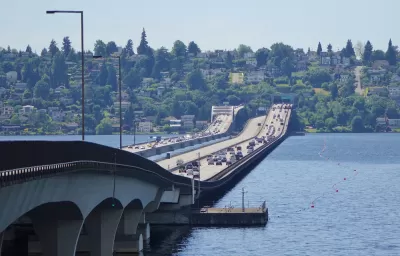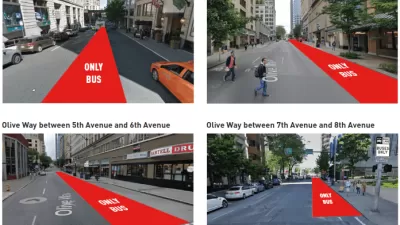The Seattle Department of Transportation is searching for ways to remove 3,000 cars from the roads every day.

The number of solo car commuters dropped by 4,500 a day in Seattle between 2010 and 2017—a laudable accomplishment and the envy of many a gridlocked city. But the Seattle Department of Transportation has set a goal to remove an additional 3,000 cars from the roads, and a few upcoming construction projects have added some pressure to the timeline on that goal.
Josh Cohen reports that the Seattle Department of Transportation launched a microtransit pilot project earlier this year, but the City Council quickly shot the project down (it's not the only microtransit experiment in the country to fall short). Still, the city is looking for solutions, according to Cohen:
But the traffic problem is growing and the city needs a solution, even if it’s not going to be with private transit experiments. One idea – supported by advocates, bus drivers and some councilmembers – is to invest deeply to improve the bus system we already have. Mayor Jenny Durkan has floated a tax on private vehicles to discourage driving downtown. Seattle’s eastside neighbors think self-driving vehicles could solve their problems. Bike advocates remind us that bikes take up far less space than cars and could help, if only we make downtown a safe place to ride.
Throughout the remainder of the article, Cohen takes a closer look at these ideas, sifting through pros and cons and the current political and economic viability of each.
FULL STORY: 5 ways to make Seattle traffic less terrible

Alabama: Trump Terminates Settlements for Black Communities Harmed By Raw Sewage
Trump deemed the landmark civil rights agreement “illegal DEI and environmental justice policy.”

Planetizen Federal Action Tracker
A weekly monitor of how Trump’s orders and actions are impacting planners and planning in America.

The 120 Year Old Tiny Home Villages That Sheltered San Francisco’s Earthquake Refugees
More than a century ago, San Francisco mobilized to house thousands of residents displaced by the 1906 earthquake. Could their strategy offer a model for the present?

In Both Crashes and Crime, Public Transportation is Far Safer than Driving
Contrary to popular assumptions, public transportation has far lower crash and crime rates than automobile travel. For safer communities, improve and encourage transit travel.

Report: Zoning Reforms Should Complement Nashville’s Ambitious Transit Plan
Without reform, restrictive zoning codes will limit the impact of the city’s planned transit expansion and could exclude some of the residents who depend on transit the most.

Judge Orders Release of Frozen IRA, IIJA Funding
The decision is a victory for environmental groups who charged that freezing funds for critical infrastructure and disaster response programs caused “real and irreparable harm” to communities.
Urban Design for Planners 1: Software Tools
This six-course series explores essential urban design concepts using open source software and equips planners with the tools they need to participate fully in the urban design process.
Planning for Universal Design
Learn the tools for implementing Universal Design in planning regulations.
Clanton & Associates, Inc.
Jessamine County Fiscal Court
Institute for Housing and Urban Development Studies (IHS)
City of Grandview
Harvard GSD Executive Education
Toledo-Lucas County Plan Commissions
Salt Lake City
NYU Wagner Graduate School of Public Service




























